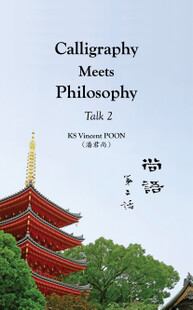Galleries and Translations > Poetry and Others > "Tranquillity allows one to arrive at thinking deeply and extensively" (寧靜致遠)
"Tranquillity allows one to arrive at thinking deeply and extensively" (寧靜致遠)
18 X 67cm
"Tranquillity allows one to arrive at thinking deeply and extensively" (寧靜致遠)
18 X 67cm in Clerical Script (隸書)
Remarks
(I)
"Tranquillity allows one to arrive at thinking deeply and extensively (寧靜致遠)" is a paraphrase of a passage in Zhuge Liang's (諸葛亮, 181-234) Admonition to His Son (誡子書):
“夫君子之行,靜以修身,儉以養德。非澹泊無以明志,非寧靜無以致遠*。”
“Alas, this is the means of an honourable person: apply tranquillity to cultivate the self, pursue frugality to raise one's character. Without freedom from materialistic ambitions, one cannot see (明) one's true aspiration; without tranquillity, one cannot arrive at (致) thinking deeply and extensively (遠)."(translated by KS Vincent Poon, Aug. 2016, revised Oct. 2022)
(II)
Zhuge Liang is a symbol of wisdom and integrity in East Asian societies. He served as the prime minister and chief military strategist for the Shu Han Kingdom (蜀漢) during the Three Kingdoms period of China (三國時代, 184-280). Liu Bei (劉備), the ruler of Shu Han, had to visit him three times before he agreed to become Liu's subordinate (“凡三往,乃見” <<三國志 . 諸葛亮傳>>).
(III)
Tranquillity is foundational to cultivating the self, for Nature enlightens us without words. Thus, the canonical Tao Te Ching asserts:
"靜為躁君。""Tranquil stillness is the lord of rash actions."
"躁勝寒, 靜勝熱。清靜為天下正。""Rash and fiery actions may temporarily overcome icy and hostile situations, yet it is tranquillity that shall ultimately and inexhaustibly overcome boiling fierceness. Pristine tranquility is the true guiding principle of all."Source: KS Vincent Poon & Kwok Kin Poon, An English Translation and the Correct Interpretation of Laozi’s Tao Te Ching. Toronto: The SenSeis, 2020, pp.33&47.
For further discussion of “Tranquillity (靜)”, please see Laozi’s Tao Te Ching.
FOR FURTHER TRANSLATION, FOOTNOTES, AND ELABORATIONS
PLEASE SEE :

Calligraphy Meets Philosophy - Talk 2 尚語 - 第二話
by KS Vincent POON (Aug. 2023)
ISBN 978-1-989485-32-3
Content is the soul of an artwork.
Thus, catching the soul of Chinese calligraphy requires understanding the literary contents. To facilitate this, the Calligraphy Meets Philosophy series presents traditional Chinese calligraphy alongside line-by-line translated texts with remarks and footnotes.
Calligraphy Meets Philosophy – Talk 2 (《 尚語∙第二話 》) includes calligraphies and translations of selected literary works by Cao Cao (曹操, 155-220 AD), Zhuge Liang (諸葛亮, 181-234 AD), Yen Shang (楊慎, 1488–1559 AD), Bai Juyi (白居易, 772-846 AD), Li Bai (李白, 701-762 AD), The Nun of the Wujinzhan (無盡藏比丘尼, ?-?AD), Wuzu Fayan (五祖法演, ?-1104AD), Longya Judun (龍牙居遁, 835-923 AD), and Kuiji (窺基, 632-682 AD).The book concludes with the author’s artwork of the entire Diamond Sutra (《 金剛般若波羅蜜經 》), followed by a short remark.
WorldCat/Library: [U of Oxford] [U of Cambridge] [Kyoto U] [Columbia U] [HKU] [National Palace Museum Taiwan] etc...
Jump to: Poetry and Others